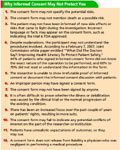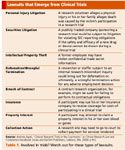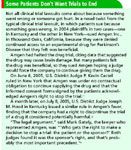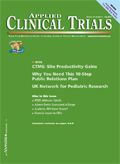A Ten Step Trial Crisis Plan
Applied Clinical Trials
Today's drug sponsors need to prepare and practice for worst-case clinical trial scenarios.
If you are not already doing so, it's time to make crisis communications preparation a standard part of your clinical trial plan. Lawsuits involving clinical research trials are on the increase, so much so that a new area of law is developing—research malpractice.

Photoography Getty Images Illustration: Paul A. Belci
Unlike standard medical malpractice lawsuits, in research malpractice plaintiffs and attorneys target just about anyone associated with a clinical trial: doctors, universities, research institutions, drug companies, clinical trial review boards, and even patent holders of certain medical devices.
Not only does this open up everyone involved to the possibility of having to make potentially large financial payouts, but more damaging and long-lasting is the negative image and damage to your institution's reputation. With today's 24-hour news cycle and the Internet, any negative news can spread around the world at lightning speed.
Add to the mix the explosion of citizen reporting and blogging and you have a volatile combination that can cause irreparable damage to all involved in a clinical trial if not properly managed. Individual, corporate and/or institutional reputations can be blemished, if not ruined.

This article provides a summary overview of the changes that have occurred in the legal and research environment, what caused them, and how researchers and institutions can prepare and manage their strategic communication plans to avert or manage these new potential crises.
A snowball effect
Until recently, few would have thought such crisis communication preparations were necessary. Two events in the 1990s triggered the change. The first was a 1995 report by President Clinton's Advisory Committee on Human Radiation Experiments, which documented abuses in radiation experiments on unwitting citizens during the 1940s. The second, and better known, was a widely publicized lawsuit involving the 1999 death of Jesse Gelsinger, an 18-year-old participant in a gene-therapy trial at the University of Pennsylvania.1
Before these incidents, lawsuits involving trials were very rare. Signed forms by participants giving their informed consent were thought to give researchers immunity against potential lawsuits. So what happened? As Alan C. Milstein, the Pennsauken, NJ, attorney who represented the Gelsinger family in its suit against the University of Pennsylvania, explained, the outcome of that case "eviscerated the cloak of immunity" that informed consent signatures had provided for the research community. The lawsuits showed it was possible to find flaws in the informed consent process and sufficient room in the wording to be successful.
Noting that he himself has successfully filed and settled 20 such cases since then, Milstein said, "Signed consent forms are no longer worth the paper they are written on. Most of the time they fail to really inform subjects in a way so they understand everything about the study and how it will affect them"2 (See Sidebar: Why Informed Consent May Not Protect You). The ensuing litigation triggered a number of similar suits alleging, among other things, inadequate informed consent, breach of informed consent, and conflicts of interest.

Why Informed Consent May Not Protect You
Rising lawsuits
Although no precise data are available on the number of injuries that have occurred from clinical trials—partly because no one government body regulates them all—or exactly how many lawsuits have been filed or settled during the past decade, clearly there is a significant trend toward more lawsuits involving clinical trials (see Table 1).3,4
Those accused range from pharmaceutical and biotech companies to hospitals and IRBs as well as individual researchers. Most of the allegations focus on the issue of informed consent, and are based on claims that the research participants did not receive enough information before agreeing to participate.3
There are a number of reasons for the spike in lawsuits, not all of them related to the massive number of clinical trials currently underway. To begin with, public distrust of pharmaceutical companies and concerns about possible lax ethics of clinical investigators and research institutions are on the rise. Lawyers say that public risks have increased over the last decade as the drug industry tries to meet Wall Street's demand for steady growth in profit.5
Greg Koski, MD, director of human research affairs at Partners HealthCare System, Boston, blames lapses in professionalism and irresponsible conduct—as well as greater awareness of these lapses by the public and legal profession—for fueling the increase in lawsuits.3
"The fundamental problem is a system in which investor-owned businesses have control over the evaluation of their own products," said Marcia Angell, editor-in-chief of the New England Journal of Medicine from 1999-2000. "Oversight of clinical trials is too important to leave in the hands of drug companies and their agents."6
Another reason is that the distinction between experimentation and treatment is becoming increasingly blurred. Many chronically ill people who lack health care coverage are increasingly relying on clinical trials for their medical care. For these people the experiments have become treatments; clinical investigators are their specialists. This is especially true in poor countries, so trial sponsors must make certain that these patients truly understand the informed consent forms. Otherwise, enrollment of these poor individuals may seem coercive or exploitative (See Sidebar: Some Patients Do not Want Trials To End).

Lawsuits that Emerge from Clinical Trials
Researchers agree that such subjects number in the thousands and their ranks are swelling. So when outcomes are not positive, people feel the need to sue, said J. Mark Waxman, a Boston attorney.3 In addition, Seattle attorney David Breskin said he believed more clinical trial lawsuits are on the horizon because the public has "become more aware of the rights of research subjects in clinical trials."4
Finally, the Internet and television advertising have made it easier for lawyers to find potential plaintiffs looking to sue. "We're looking to make sure that people know they have a claim, and they know they are represented if they choose to be," said Charles S. Zimmerman, a Minneapolis lawyer.5
Following the money
Much of the zeal of plaintiff lawyers comes from the increasing aggressiveness and wealth of the trial bar. Like Willie Sutton, who famously explained that he robbed banks because "that's where the money is," trial lawyers, enriched and emboldened after successful fights against asbestos and tobacco companies, have increasingly trained their sights on drug makers.5
A number of plaintiff law firms have joined forces to fight complicated cases in the hope of multimillion dollar payoffs. Even when lawyers don't form explicit partnerships, they work together and trade information at conferences with names like "Mass Torts Made Perfect" and "The Knowledge to Conquer." Said lawyer J. Michael Papantonio, of Pensacola, Florida: "It's a different day out there."5
This is bad news for clinical researchers. CenterWatch, a clinical trials listing service, estimates that the number of industry trials rose worldwide from 40,000 in 2000 to 59,000 in 2006.8 In October 2008, the U.S. government reported 62,693 clinical trials ongoing in 158 countries.9 As the number of trials continues to balloon, so too does the probability of something going wrong—the more drug trials, the higher the risk of malpractice lawsuits.

Some Patients Do not Want Trials to End
Tough odds
Consider just a few of the many things that could go wrong during a trial. To begin with, potential risks abound when you are dealing with medicines, even FDA-approved meds. The wrong drug may be administered or the wrong dose given. Neither is it uncommon to find drugs mislabeled or contaminated. Some researchers have even been unlucky enough to be involved in trials that experienced unfortunate issues such as serious adverse events, especially death. Then, too, there are the unforeseen adverse events that were not reported to researchers in a timely manner so that the events might have been averted.
And today more and more people without health care coverage are using clinical trials for their medical treatment. This frequently results in the enrollment of ineligible persons and, deliberate or not, an improper informed consent process. So when unforeseen adverse events occur, the consequences are even more damaging.
Ramifications can be significant: Aside from losing time and money spent investing in the new drug or device, federal funding could be taken away, all trials (not just the one from which the allegation emanated) could be stopped, and both civil and criminal fines and penalties are possible.10
But far more damaging and long-lasting is the negative image and damage to your institution's reputation. All we have to do is open any newspaper or general circulation publication to read negative news about clinical trials. All of these stories are unfortunate, and sometimes heartbreaking. However, we can never say they were unforeseen.
As professionals responsible for clinical trials we can foresee most negative issues relating to trial implementation. Whether we have experienced negative issues personally or have witnessed these issues from afar, we should all learn from them that it is not a matter of if they will happen again, it is a matter of when they will happen again.
In case of emergency
Our intimate knowledge of the clinical trial development, recruitment, and reporting processes makes us experts on what can and will go wrong. Knowing this, we should do our best to develop plans and mechanisms to prepare for these issues and mitigate their impact on our other clinical trials and on clinical research overall.
One of the first steps is to approach your corporate public relations staff or external PR firm and ask for help. In addition to the PR team assuming the lead role in this work, key corporate functions at the table should include representatives from the legal, medical, regulatory, and corporate departments of your company or client company. Once the team is identified and has agreed that a strategic issues management plan is necessary, it's time to get to work.
Following are 10 steps for developing and implementing an effective issues management plan.
1. Try to anticipate every conceivable (and perhaps inconceivable) worst-case scenario. What could befall your clinical trials that could require media contact? Ask yourself questions such as: What are the greatest risks? Who could be impacted? How severely? What assistance can we provide? Who are our third-party advocates?
2. Develop a response for each scenario. Prepare a comprehensive Q&A and set of key talking points that address the public's concern for that particular situation. Talking points are facts that are incorporated into your formal response, such as your organization's concern about what happened, their philosophy regarding consumer safety, and the immediate steps to be taken. Unless you prepare your responses in advance and continually practice them, it is almost impossible to respond effectively to the press. There are too many other things to think about and do once crisis hits.
3. Coordinate your media responses with your legal department in advance. Attorneys are cautious by training, sometimes overly so from a PR standpoint. Make sure you know all the legal ramifications involved, especially if there are lawsuits pending. Try to strike a balance between privacy rights, possible admissions of negligence or guilt, and the public's right to know. Get written clearances beforehand for prepared statements that can be distributed to the media.
4. Never tell the press "no comment." It's the worst thing you can say, because then you open the situation to speculation, most of which will probably be wrong. But the damage will have been done by the time you get around to responding. "No comment" automatically implies guilt or that there is something to hide. (That's another reason you want to have responses prepared in advance for every possible contingency.) If you don't know the answer, just say so. Tell the reporter you will try to find someone who has the answer and will get back to him or her.
5. Designate a corporate spokesperson (and a back-up). This person will represent the company when talking to the press, so make certain everyone in your organization knows who that person is. Caution all company personnel they are not to speak with any reporters but to refer them instead to the designated spokesperson. It is imperative that your company speak with one voice, one message. Make certain your spokesperson understands the importance of never answering hypothetical questions or questions involving conjecture or speculation.
6. Hold crisis training media drills. This way everyone knows their role, where to go, and what to say. Have staffers play reporters questioning your spokesperson so they can practice the appropriate prepared responses. Like any other activity involving practice, the more your spokesperson practices crisis responses, the better they will be if an actual crisis develops.
7. Review your anticipated scenarios and responses periodically. Try to determine whether you need to update your anticipated situations or your planned responses.
8. Institute a media monitoring system if you don't already have one. Many media and a number of Internet search services now provide instant messaging regarding news reports that include the designated key words you've chosen for following coverage. Use them and make certain someone monitors the reports as they come in. Consider it part of that early warning system discussed previously. Your PR department or external PR firm can help you find the right media monitoring mix.
9. Stay calm when crisis strikes. Take your time to assess the situation carefully, then implement your plan. You will be able to effectively manage whatever crisis comes your way if you have carefully prepared, updated, and practiced your plan. Remember, you have control over what you say, how you say it, and when. That's why it is so important to prepare for all possible crises in advance.
10. Above all, be truthful. Reporters are by nature skeptical. But as recent surveys show, the public is growing ever more cynical about drug makers. According to the Kaiser Family Foundation survey, only 18% of consumers believe pharma ads can be trusted "most of the time." That's down by almost half since 1997, when one-third of people surveyed said pharma ads could be trusted most of the time.
Be prepared
No two organizations are exactly alike. Each company, institution, hospital, university, and research laboratory has its own unique qualities and should try to capitalize on these distinctions. Nonetheless, no organization can assume that because it has always done well in the past, it will continue to do well in the future.
As this article points out, participants in research studies and their lawyers have become more aggressive in seeking damages for personal injuries and deaths alleged to be the result of participation in a clinical research trial. Informed consent and signed forms no longer provide immunity against such lawsuits, because plaintiff lawyers have become more aggressive and more skilled at finding legal technicalities that can result in multimillion dollar payouts. If your organization does not already have a crisis communication plan as part of its standard operating procedures, what are you waiting for?
John F. Kouten is the chief executive officer of JFK Communications, Inc., 5 Independence Way, Suite 300, Princeton, NJ 08540, email: jfkouten@jfkhealth.com
References
1. E.H. Morreim, "Litigation in Clinical Research: Malpractice Doctrines Versus Research Realities," The Journal of Law, Medicine & Ethics, 34 (4) (October 1, 2004).
2. A.C. Milstein, telephone interview and email exchanges, July 30 to August 2, 2008.
3. Nora Lockwood Tooher, "Clinical Trial Lawsuits on the Rise Across the Country," Lawyers Weekly USA (August 29, 2005).
4. T. Baldas, "Drug Trials on Trial," The National Law Journal, http://www.sskrplaw.com/publications/050718.html (July 21, 2005).
5. A. Berenson, "Trial Lawyers Are Now Focusing On Lawsuits Against Drug Makers," The New York Times, A1 (May 18, 2003).
6. D. Evans, M. Smith, L. Willen, "Drug Tests' Side Effect: Conflict of Interests," Bloomberg News Service (November 6, 2005).
7. G. Kolata and K. Eichenwald, "STOPGAP Medicine: A Special Report: For the Uninsured, Drug Trials Are Health Care," The New York Times, A1 (June 22, 1999).
8. S. Rubenstein, "When Drug Trials Go Wrong, Patients Have Little Recourse," The Wall Street Journal, p. 1 (January 31, 2008).
10. A. Agati, "Clinical Research Trials In the Courtroom," Clinical Research Law and Compliance Handbook (Jones and Bartlett Publishers, Sudbury, MA, 2006) p 412.
11. Suthers v. Amgen, No. 05-CV-4158 (S.D.N.Y.)
12. Abney v. Amgen, No. 5:05-CV-254 (E.D. Ky.)

Improving Relationships and Diversifying the Site Selection Process
April 17th 2025In this episode of the Applied Clinical Trials Podcast, Liz Beatty, co-founder and chief strategy officer, Inato, discusses a number of topics around site engagement including community-based sites, the role of technology in improving site/sponsor relationships, how increased operational costs are impacting the industry, and more.